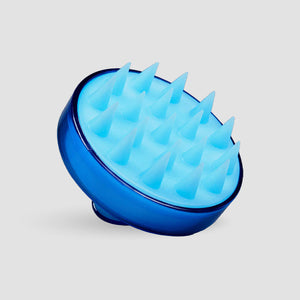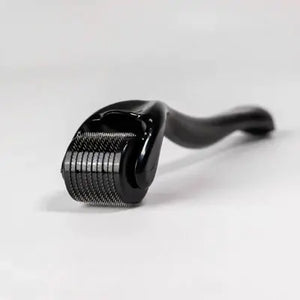
Tension hair loss - what is it?
Table of contents
- What is tension hair loss?
- How do you recognize tension hair loss?
- What helps against tension in the cranial muscles?
- What helps if the hair roots have already died?
- Conclusion: In advanced cases of alopecia contentionalis, a hair transplant can help
What is tension hair loss?
So-called tension hair loss (alopecia contentionalis) is a specific form of androgenetic alopecia , or hereditary hair loss. This form of hair loss is triggered or at least significantly exacerbated by severe muscular tension in the upper scalp .
Alopecia contentionalis can be triggered by stress, among other things. Prolonged stress or emotional distress can lead to constriction of the blood vessels in the scalp.
The narrowing of the blood vessels in the scalp affects the supply of nutrients , as without an adequate blood supply, nutrients cannot be transported to the hair follicles. However, both various nutrients and oxygen are extremely important, as they significantly support the cellular biological processes of the hair follicles.
Due to the lack of oxygen that occurs with tension hair loss, increased levels of dihydrotestosterone, the hormone DHT, accumulate in your skull. This is a breakdown product of the male hormone testosterone. Androgenetic alopecia is caused by hypersensitivity of your hair follicles to this hormone.

Because the hair follicles can no longer receive sufficient nutrients, the growth phase of the hair roots is interrupted , and the hair falls out. The result is a degeneration of the hair follicles, which triggers hair loss and ultimately causes irreversible damage to the hair roots.
Hair loss is particularly pronounced during periods of stress or significant strain. Even if your hair does grow back, it usually feels very thin and straw-like.
How do you recognize tension hair loss?
It's important that you always have a doctor examine the cause of your hair loss. Only when the cause is known can a suitable treatment be found.
For tensional hair loss, a detailed individual and family history will be taken first. In addition , the tension in your upper cranial muscles may be measured using an EMG ( electromyography ) device. Using this device, the doctor can determine whether your muscle tension is elevated.

In addition, this form of hair loss is often accompanied by so-called hair pain . This manifests itself, for example, as an unpleasant burning, tightness, itching, or tingling sensation on the scalp. Many sufferers also experience severe neck tension or nighttime teeth grinding .
This form of hair loss usually begins at the crown, the receding hairline, or the forehead. This is followed by the formation of a tonsure at the back of the head. Many affected individuals also experience increased wrinkling in the forehead area .
What helps against tension in the cranial muscles?
If the cause of your hair loss is tension in your cranial muscles, you should first try to relieve the muscle tension in the affected areas of your skull. It's important to aim for lasting relaxation of the cranial muscles .
It is important to restore adequate blood flow to these areas of the skull . If this therapeutic goal is achieved, the still active hair follicles can be protected from the progression of hair loss.
As long as the hair follicles are still active, it's possible for them to transition from their resting phase back into the growth phase. However, if alopecia contentionalis isn't detected and treated early, the hair roots can die permanently due to a lack of nutrients and oxygen.
What helps if the hair roots have already died?
If your hair roots are already irreversibly damaged, no hair growth products or therapies will help restore healthy and strong hair growth. Dead hair roots can never produce new growth.
In such a case, only a hair transplant can help fill in the bald spots. If you decide to undergo a hair transplant, you should always have it performed at a reputable and competent clinic.

Elithair offers hair implantation in Istanbul with high quality standards. Dr. Balwi is an expert in the field of hair transplantation and has successfully achieved full and healthy hair growth in over 100,000 patients .
The hair transplant is performed using the proven and gentle FUE method of hair follicle extraction to achieve the best possible results. Before the hair is transplanted using a suitable technique (DHI, Sapphire, or SDHI), the relevant areas on your head are first locally anesthetized.
Next, the follicular unit harvesting procedure takes place. Hair follicles are individually removed from an area at the back of your head using a hollow needle. In the laboratory, the harvested grafts are placed in a special nutrient solution before being reimplanted into your scalp.
The implantation of hair follicles requires a particular level of sensitivity to ensure the final result is aesthetically pleasing and, above all, natural. Just a few months after your hair transplant, you will notice hair beginning to grow in the recipient area. You will need to wait about a year to see the final results of the transplant.
Conclusion: In advanced cases of alopecia contentionalis, a hair transplant can help
Alopecia contentionalis is a specific form of hereditary hair loss and is triggered by severe tension in the cranial muscles. This disrupts the supply of nutrients and oxygen to the hair roots , which can lead to hair loss over time.
In extreme cases, tension hair loss has progressed so far that the hair roots have completely died and can no longer produce growth. In this case, even scalp relaxation therapy will no longer help stimulate hair growth.
The experts at Elithair, led by Dr. Balwi, can help you regain full, healthy hair. A hair transplant is the ideal and, above all, permanent solution for regrowth, even in bald patches. With new, healthy hair, you'll regain self-confidence and a sense of quality of life.




















